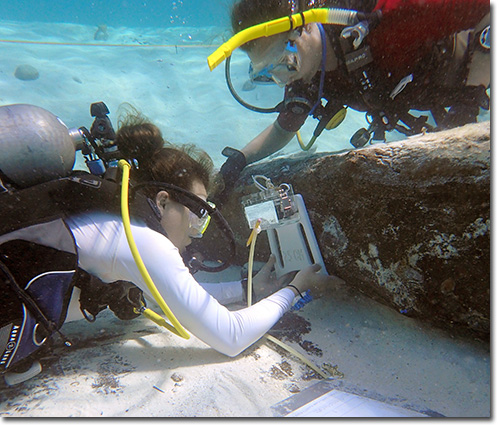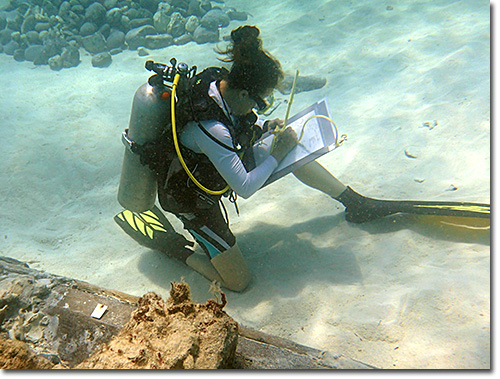Angles of Reconstruction of the Pillar Dollar By Dorothy Sprague June 3, 2016

Dorothy Sprague and Allyson Ropp using a goniometer to measure the angles of the bottom of a frame on site (photo by J. McKinnon 2016).
Today I collected data for a reconstruction of the Pillar Dollar shipwreck using a goniometer. A goniometer is effectively a digital protractor that measures surface angles across a set distance. The angle being measured is between the two ends of the goniometer, which on ours is set to measure 25 centimeters. After collecting this data across a whole section, whether that be a plank or a frame, the full curve can be created and extrapolated to understand the physical remains on the sea floor and the non-existent pieces that have long since degraded away.
I used a goniometer today to collect data on the curvature of the planks on this shipwreck. I had previously collected data on the curvature of the frames; however, I worried that the previously collected data may have been seriously impacted by the amount of marine life and coral growth that covered large portions of the wood as well as the degradation of the frames themselves. On this dive I took goniometric data for the planks that had been uncovered underneath the frames, measuring their curvature along the bottoms of the frames as they lay on the seabed. I also took this opportunity to measure the curvature of a frame located a short distance away from the main portion of the wreck.

Dorothy Sprague recording measurements of the keel for reconstruction of the Pillar Dollar vessel (photo by A. Ropp 2016).
The data that I have now collected will aid in a reconstruction of the ship before the wrecking event. It is my intention to use the measurements of the frame elements to attempt to reconstruct the shape of the vessel as it was when built. As I continue to process the data and get approximate hull lines, it may be possible to determine what part of the ship remains on the sea floor. The reconstruction of the vessel can also aid in understanding its size and tonnage. This data and the reconstruction can potentially lead us to identify the nationality of the vessel.
Previous Next

